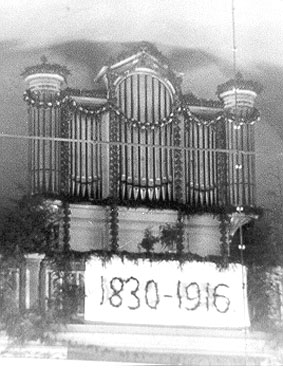|
HISTORICAL ORGANS IN FINLAND 
Urjala sacristy upstairs- Råman, Johan 1830
- 8 stops, 1 manual and pull-down pedal
- mechanical action and mechanical stop action
The cruciform wood church of Urjala was built by Martti Tolpo in 1806. The organ for the church was built by Johan Råman, the Estonian-born master builder of the Town of Hämeenlinna. It was the first organ in this church, and one of the first in the rural parishes of the province of Häme. The organ was in use until a new instrument was built in 1912. At that time, the old instrument, instead of being dismantled, was moved — apparently in its entirety, though with pipes removed — down from the loft, to the sacristy and up to the former village hall on the first floor (the ceiling being torn out for this purpose). Roof supports in the village hall had to be sawed through to provide space for the organ. The framework of the instrument is intact, and the action is complete, but the pipes are partly spread on the floor of the village hall.
When Finland was taken over by Russia in 1809, organ building came to an almost complete standstill for a few decades. Even with its ‘wings clipped’, the Urjala organ is an important monument of Finnish organ building during that era. It was apparently the first organ that the builder had ever built, although he was already 50 years old at the time.
Appearance
The façade has five sections. In the middle stands an arched flat formed of the largest Principal pipes, topped with a pediment. Flanking this are straight flats consisting of smaller pipes. The outermost towers of the façade are unique. They are round barrels made of glued wood, with pipes painted on them. Some of the façade pipes are speaking, others are dummies. In the latter, only the front half of the pipe is of tin; the rear half is the mounting board. The builder left his signature in the foot of the largest pipe; only one other such signature has been preserved in Finland. The frame-built organ case contains everything else except the bellows, which are housed in a separate bellows cabinet behind the instrument.
Technical features
The chest is precisely and skilfully crafted, and its structure shows the influence of contemporary Swedish builders. The chest is a sponselled lamellar slider chest whose organization reflects that of the façade.
The organ has a wedge-shaped single-fold reservoir bellows and a similar feeder bellows under it, operated with a pumping pedal. The wind trunks pass from the reservoir bellows through many twists and turns under the rollerboard and into the pallet box. There are no concussion bellows, and the organ has never had a blower.
The console is at the left edge of the organ. All the components of the console are precisely and skilfully crafted. The naturals have a hardwood veneer stained black, with decorations of compressed paper on the key ends. The sharps have a bone veneer. The keys are heavily worn through use.
The action proceeds from the keys to a horizontal rollerboard and to pallets at the rear edge of the chest. Each roller on the wood rollerboard is mounted on two centre point bearings, one of which is adjustable.
The stop knobs are in a single line between the music stand and the keyboard. The knobs are in the same order as the sliders, and since the chest is almost at the same height as the knobs, the stop action is very simple.
Musical properties
The pipe mensuration follows the principles of certain Swedish builders. The manufacture of the pipes, or ‘hallmark’, is much along the same lines. The structure of the reed stop (Trompet) implies a choral sound blending with the flue stops. The disposition is slightly archaic for its era, and it lacks certain typical stops. However, we may assume that the sound of the instrument corresponded with the Swedish tradition. This remains an assumption, though, since the instrument has been unplayable ever since it was moved to the village hall.
Disposition
Manual C-c3 |
|
|
Principal 8’ | | |
Gedacht 8’ | | |
Octava 4’ | | |
Spetsfleut 4’ | | |
Qvinta 3’ | | |
Octava 2’ | | |
Scharf 3chor | | |
Trompet 8’ | | |
Sperrventil (cut-out valve) | | |
| | |
| | |
Pull-down pedals C-g0 | | |
| | |
|